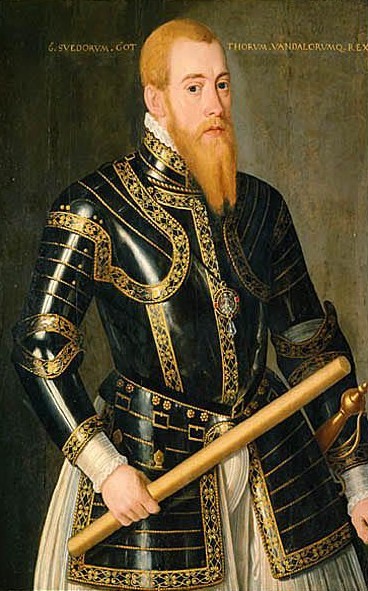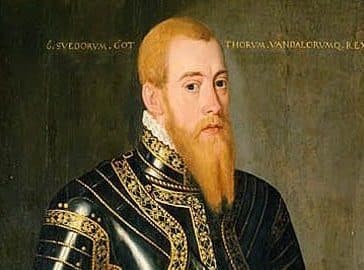
This is a guest post from Stanley Antonisson – a man who for years has been adding fascinating comments to my posts. Stanley is a Swede himself and the perfect person to paint this portrait of Erik XIV of Sweden, one of Elizabeth’s ardent suitors. Hope you enjoy!
* * *
Erik Gustavsson Vasa was born on December 13, 1533, at the Royal Tre Kronor Castle in Stockholm as the eldest son of Gustav I Wasa (1496 – 1560) from his first, unhappy marriage to Catherine of Saxe-Lauenburg (1513 – 1535), who died before Erik’s second birthday. His father took as his second wife the Swedish Margareta Leijonhufvud (1516 – 1551), and when she diead, he married again with the Swedish Catherine Stenbock (1535 – 1621).
As a youth Eric had been a talented young man and a true Renaissance Prince. He and his half brothers had received a typical Renaissance education, including geography, history and political thought. Eric had aesthetic, cultural and astrological interests, played the lute and even wrote some compositions of his own. He was skilled in several languages and military science had his special interest. Still, he seemed more adept at abstract thought than at practical politics.
In 1557, Gustav Wasa made his eldest son a duke and granted him some provinces with Kalmar as residence. Eric surrounded himself with a group of gifted, well-educated young men from simple backgrounds. Together they adopted a decadent lifestyle. Eric liked good food and drink, art and music, and splendid clothes and display. He was handsome and well-built, approx. 179 cm. tall. He was also an excellent rider, swimmer and dancer, but, since his youth, he drank to excess.
During this time, against his father’s wishes, Erik entered into marriage negotiations with the future Queen Elizabeth I of England (1533 – 1603) and pursued her for several years. He sent her love letters in Latin and dispatched his uncouth half-brother John (1537 – 1592) to her court to press his suit, but Elizabeth managed to keep Eric dangling for years without any real intention of marrying him, but even refusals could not deter Eric from his wooing.
After that Erik succeeded his father as King of Sweden on September 29, 1560; he wanted to visit Elizabeth to seduce her personally and set sail for England, but the elements were against him and his fleet was scattered. Eric also made marriage proposals to Mary, Queen of Scots (1542 – 1587), but negotiations for a marriage came to nothing either. He ruined his chances with other Princesses as Renata of Lorraine (1544 – 1602), Anna of Saxony (1544 – 1577) and Christine of Hesse (1543 – 1604) by his own fickleness.
Finally, Erik fell in love with young and beautiful Karin Månsdotter (1550 – 1612), who was the daughter of a soldier or jailer. In 1566, she gave birth to a daughter Sigrid, and Eric married Karin secretly on July 13, 1567. After the birth of their son Gustav, he married her publicly on July 4, 1568, and had her crowned the next day. The aristocrats were offended that Eric preferred a commoner to one of their relatives and his insecurity led Eric to suspect that people were laughing at him for his choice of bride.
It was Erik’s ambition to make Sweden a dominant power in the Baltic area. During his reign, the “Nordic Seven Year’s War” was fought against both Denmark and Poland, which resulted in much brutality against the civilian population. Occasionally, Eric assumed military command, but he spent most of the war in the company of his private circle of advisers and friends at one of his castles. In 1562, his half-brother John defied Erik by marrying the Polish Princess Catherine Jagiellona (1526 -1583) and invading Livonia.
John was imprisoned together with his new wife and feared for his life. John’s loyal servants were executed, but eventually John was released and he and Eric fell at each other’s feet in tears. Slowly, Eric’s mind was becoming unhinged and he showed signs of schizophrenia in his alternating moods of violent frenzy and abject repentance. Two guards were sentenced to death for ‘annoying the King’. If someone smiled or whispered in his presence, Eric believed that he was ridiculed.
A sudden movement or an unfortunate gesture would trigger his latent violence. Like his father, he could suddenly fly into a violent rage. Whispering, clearing one’s throat or coughing at inappropriate moments were seen as obvious signs of plotting. With his sword drawn, Eric stalked restlessly through the corridors of the Royal castle looking for someone to find fault with. Still, there was no immediate attempt to depose Eric, when, in 1567, Erik ordered the arrest of a number of aristocrats and condemned them to death.
For several months afterwards he suffered from a mental depression and withdrew to the Castle of Svartsjö, outside Stockholm, neglecting affairs of state. During Erik’s illness, a Council of the Realm took over the government and tried to restore calm. After six months, Erik felt better and resumed power. In periods, when Eric was confused, his reliance on his wife and his favourite Göran Persson was complete, and the nobility resented to be ruled by these “social upstarts”.
In September 1568, his half-brothers, John and Charles captured Stockholm and Erik surrendered to them. John was subsequently proclaimed King John III. Early 1569, Erik was brought to trail for his misdeeds, but he strongly resisted the suggestion that he had ruled tyrannically. Nevertheless, he was formally deposed and imprisoned with his young wife and children. Their other sons, Henrik and Arnold, were born in captivity, where Erik translated Johannes Magnus’s imaginary history of the Goths into Swedish.
Later Erik was separated from his wife and children and moved from castle to castle, because various plots against the new King made him fearful of his elder brother. Erik was kept in conditions of increasing harshness and eventually seemed to have relapsed into total madness. He was not the only madman in the family; his half brother Magnus of Ostergotland (1542 – 1595) had been an insane schizophrenic since his youth.
After a couple of years, King John received a formal sanction from the more influential members of the Riksdag to take his elder brother’s life, should he be threatened by further rebellions. On February 26, 1577, at Örbyhus Castle in Uppland, Eric died in agony, probably poisoned with arsenic mixed in his pea soup. A public announcement stated that he had died “after a long illness”. He was buried in Västerås Cathedral. Erik’s widow, Karin Månsdotter, was granted lands and an income enabling her and her children to live in comfort. She survived her husband by 35 years. Their only surviving son, Gustav (1568 – 1607), inherited his father’s mental defects and died childless.
- Letter written by Queen Elizabeth I of England to King Eric XIV of Sweden, February 25, 1560
- King Erik XIV of Sweden’s grave in Västerås Cathedral in Västmanland, Sweden
- Short history of Three Crowns Castle in Stockholm, Sweden, destroyed in a violent fire in 1697
* * *
If you like my posts, you’ll love my books! The Path to Somerset came out on August 24 – have you ordered your copy yet? Click on the photo to be taken to Amazon.Com:
(What? You haven’t read Jane the Quene yet? Here are some easy links to Amazon.Com, Amazon.Co.UK and Amazon.Com.Au!)


Be First to Comment